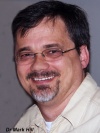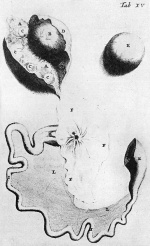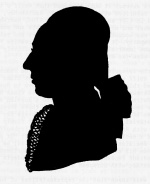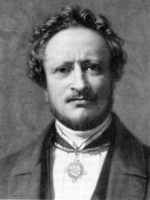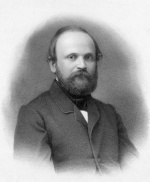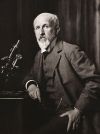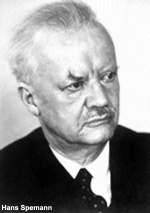History - Embryologists
| Embryology - 27 Apr 2024 |
|---|
| Google Translate - select your language from the list shown below (this will open a new external page) |
|
العربية | català | 中文 | 中國傳統的 | français | Deutsche | עִברִית | हिंदी | bahasa Indonesia | italiano | 日本語 | 한국어 | မြန်မာ | Pilipino | Polskie | português | ਪੰਜਾਬੀ ਦੇ | Română | русский | Español | Swahili | Svensk | ไทย | Türkçe | اردو | ייִדיש | Tiếng Việt These external translations are automated and may not be accurate. (More? About Translations) |
Introduction
See also Meyer's 1932 series of essays on this topic.
Meyer AW. 1932 - Essays on the History of Embryology: Part I | Part II | Part III | Part IV | Part V | Part VI | Part VII | Part VIII | Part IX | Part X | Part XI | Arthur Meyer | Historic Embryology Papers
For information related to early embryologists in the United States see the book The Emergence of Experimental Embryology in the United States by S. Robert Hilfer, Ph.D. 1990.
Much of the early history of embryology was European based and in the 19th Century mainly German researchers began the detailed description of human development. Later this included United Kingdom and then USA based researchers.
| Embryologists: William Hunter | Wilhelm Roux | Caspar Wolff | Wilhelm His | Oscar Hertwig | Julius Kollmann | Hans Spemann | Francis Balfour | Charles Minot | Ambrosius Hubrecht | Charles Bardeen | Franz Keibel | Franklin Mall | Florence Sabin | George Streeter | George Corner | James Hill | Jan Florian | Thomas Bryce | Thomas Morgan | Ernest Frazer | Francisco Orts-Llorca | José Doménech Mateu | Frederic Lewis | Arthur Meyer | Robert Meyer | Erich Blechschmidt | Klaus Hinrichsen | Hideo Nishimura | Arthur Hertig | John Rock | Viktor Hamburger | Mary Lyon | Nicole Le Douarin | Robert Winston | Fabiola Müller | Ronan O'Rahilly | Robert Edwards | John Gurdon | Shinya Yamanaka | Embryology History | Category:People | ||
|
Francesco Redi (1626 - 1698)
| Francesco Redi was a natural philosopher at the Medici court and physician to two Grand Dukes of Tuscany. His experiments disproved the "spontaneous generation" theory, showing that insects do not spontaneously generate from decaying matter.
See Meyer's 1931 essay[1] on the Idea of Spontaneous Generation. |
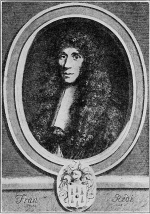
|
Reinier de Graaf (1641 - 1673)
| A Dutch embryologist who published works on female genital organs. He was first to describe the "Graafian follicle" in the ovary of mammals, but erroneously believed the entire follicle to be the mammalian oocyte (egg).
After Table 15 of de Graaf: A, a. testlculus secundum Iongitudlnlm apertus
|
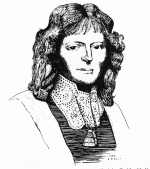
|
Giovanni Battista Morgagni (1668-1771)
| An Italian anatomist and Professor of Anatomy at the University of Padua. | 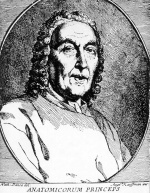
|
Caspar Friedrich Wolff (1733 - 1794)
- Links: Caspar Friedrich Wolff | Renal System Development | Genital System Development | Theoria generationis | Germ Layer Theory
Karl von Baer (1792-1876)
| Professor at the University of Königsberg published Über Entwickelungsgeschichte der Thiere (On the Developmental History of Animals) 1828.
From Thomas Henry Huxley translation in Scientific Memoirs:[2]
|
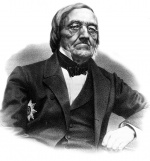
|
Martin Heinrich Rathke (1793 - 1860)
| Rathke was a German embryologist and anatomist best known today for identifying "Rathke's pouch" (1839), a transient folding surface ectoderm from roof of the oral cavity that will form the anterior pituitary (hypophysis). in later development the connection with the oral cavity is lost. Rathke's fold refers to the transient lateral components formed during development of the urogenital septum, dividing the rectum from the urinary bladder.
Rathke studied medicine at the University of Göttingen and later in Berlin, where he received his doctorate in medicine (1818).
|
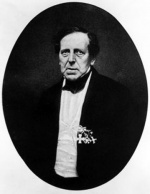
Martin Rathke |
Jones Quain (1796 - 1865)
Jones Quain (1796 – 1865) was an Irish anatomist and professor of Anatomy and Physiology at the University of London. His textbook "Elements of Anatomy" was first published in 1828.
- 1878 Elements of Anatomy: The Ovum | The Blastoderm | Fetal Membranes | Placenta | Musculoskeletal | Neural | Gastrointesinal | Respiratory | Cardiovascular | Urogenital
Johannes Peter Müller (1801 - 1858)
Robert Remak (1815 - 1865)
Rudolph Albert von Kölliker (1817 - 1905)
Albert von Kölliker (1817 - 1905) (Rudolf Albert Kölliker) was a Swiss anatomist, physiologist, and histologist.
|

|
Julius Kollmann (1834 - 1918)
| Kollmann was a German embryologist and Professor extraordinarius, Munich University, 1870–8; professor of anatomy, Basel University, 1878 – 1913. Images from Kollmann's 2 volume Atlas of the Development of Man (Handatlas der entwicklungsgeschichte des menschen) were extensively reused in other embryology textbooks and are also the basis of many modern drawings.
|
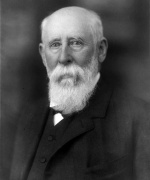
Julius Kollmann |
Carl Ludwig (1816 - 1895)
| Carl Ludwig |
Wilhelm Roux (1850 – 1924)
| Roux was a German zoologist and pioneer of experimental embryology. Described "Entwicklungsmechanik" (mechanisms) a physiological approach to embryology. One experiment used a heated needle to kill at the frog 2 cell stage one of the blastomeres. Doctoral thesis - On the bifurcation of blood vessels. A morphological study.
|
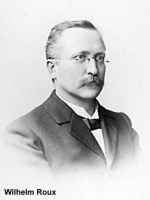
Wilhelm Roux |
Wilhelm His (1831 - 1904)
| His was a noted Swiss anatomist and embryologist educated in Basel and Bern, in Berlin. His teachers in Würzburg were Johannes Peter Müller (1801-1858) and Robert Remak (1815-1865) and in Prague and Vienna with Rudolf Virchow (1821-1902). All three of these researchers were major 19th century embryologists.
Wilhelm His was a Swiss anatomist and embryologist.
|
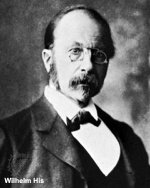
Wilhelm His |
Ambrosius Hubrecht (1853 – 1915)
| A Dutch zoölogist who received his Ph.D. under Halting on a study of the anatomy, histology and development of the worm group Nemerteans. He created the Institut International d'Embryologie (International Institute of Embryology) in Utrecht, The Netherlands, in 1911. He supported Charles Darwin's work, and collected specimens of embryos from around the world to demonstrate evolutionary connections between animals.
|
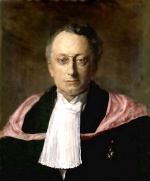
Ambrosius Arnold Willem Hubrecht |
Charles Sedgwick Minot (1852–1914)
| Charles Sedgwick Minot (1852–1914) was an American anatomist and embryologist. In 1883 he was appointed instructor in histology and embryology in the Harvard Medical School. His embryological collection, The Harvard Embryological Collection (the Minot Collection) now forms part of the Carnegie collection.
|
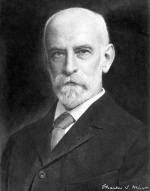
Charles Sedgwick Minot (1852–1914) |
Oskar Hertwig (1849 – 1922)
| Oskar Hertwig was a German embryologist, Professor extraordinarius of Anatomy and Comparative Anatomy, Director of the II. Anatomical Institute of the University of Berlin. In 1875 identified ((fertilisation}} in the egg of the sea-urchin (Toxopneustes lividus) occurred when the nucleus belonging to the egg fuse together with the nucleus derived from the spermatozoon.
|
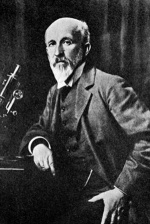
Oskar Hertwig |
| Historic Embryology |
|
Oscar Hertwig (1849-1922) was a German embryologist and anatomist who first identified in amphibia tooth development, and was subsequently named Hertwig's epithelial root sheath (HERS). In amphibia, this is a permanent structure. In mammals, this is a transient structure, assembled during early tooth root formation and elongation. Later the HERS becomes fenestrated and reduced to the epithelial rests of Malassez (ERM).[3] |
Theodor Heinrich Boveri (1862 – 1915)
| Theodor Heinrich Boveri (1862 – 1915) was a German biologist at the Institute of Zoology in Würzburg. In 1902 using the sea urchin model, identified the role of nuclear chromosomes in development.[4] | 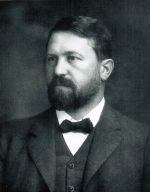
|
Franz Keibel (1861 - 1929)
| Franz Keibel (1861 - 1929) was a German anatomist and embryologist. Beginning in 1897 he was the editor of the series "vertebrate embryological standard panels" (Normentafeln zur Entwicklungsgeschichte der Wirbeltiere), published in German, each volume covered a specific vertebrate species. This included human embryos (Homo sapiens). These standard tables form the basis of the modern embryological staging systems.
|
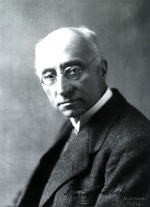
Franz Keibel |
Franklin P. Mall (1862 - 1917)
| Mall is most remembered for his work done at the Department of Embryology at the Carnegie Institute of Washington. He began collecting human embryos while a postgraduate student in Lepzig with Wilhelm His, but didn't receive the first Carnegie specimen until his position at Johns Hopkins University.
|
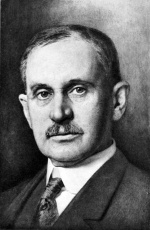
Franklin Mall |
Florence Sabin (1871 - 1953)
| Sabin generated a three-dimensional model of a newborn human brainstem, An Atlas of the Medulla and Midbrain (1901) and published on the embryological development of the lymphatic system while at the Johns Hopkins School of Medicine under Franklin Mall.
|

Florence Rena Sabin |
George L. Streeter (1873 – 1948)
| Streeter was an American embryologist, holding many key positions during embryology discoveries in the early period of last century, and also associated with the establishment of the Carnegie Institution.
|
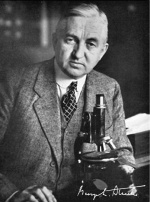
George Streeter |
Santiago Ramón y Cahal (1852 - 1934)
| Cahal was a Spanish pathologist and histologist and one of the early neuroscientists. He received the Nobel Prize in Physiology or Medicine.
From the 1990 Science book review.[5]
|
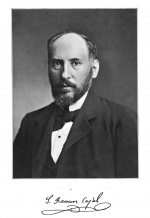
Ramon y Cahal |
Hans Spemann (1869 - 1941)
Viktor Hamburger (1900 - 2001)
Founding researcher in the field of developmental neuroscience, establishing the role of neurotrophic factors for neuronal survival during development.
|
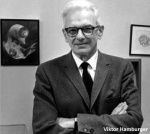
Viktor Hamburger |
Mary Lyon (1925 - 2014)
| Mary Lyon was a UK geneticist who proposed in 1961 the theory of X chromosome inactivation, where one of the two X chromosomes in the cells of female mammals is randomly inactivated during early development. In deference to her, this process is also referred to as "Lyonisation". She also worked on other X-linkedgenetic diseases, such as Duchenne muscular dystrophy and haemophilia.
|
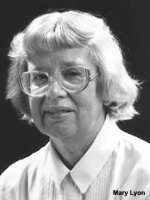
|
Shinya Yamanaka (1962 - )
Obituaries
2016
- Andrzej Tarkowski (September 23 2016) Professor, who discovered a microscopic imaging method for analysing chromosome structure of mouse oocytes. telegraph 2016 |[ https://www.the-scientist.com/the-nutshell/famed-mammalian-embryologist-dies-32420 the scientist] Search Pubmed - Tarkowski A
2018
- John E. Sulston (6 March, 2018) Professor, British biologist who won the Nobel Prize in Physiology or Medicine ( 2002) for worm development. Nature | [dev.biologists.org/content/145/9/dev166538 Development] Search Pubmed - Sulston J
- John D. Biggers (April 7th, 2018) PhD, DSc Professor Emeritus, Harvard Medical School, Massachusetts, USA. IVF Research Pioneer Search Pubmed - Biggers J
- Ronan O'Rahilly (June 24, 2018) Professor, School of Medicine, University of California, Davis, CA, USA. Search Pubmed - O'Rahilly R
- William McBride (27 June, 2018) Australian obstetrician who warned about the teratogenic effects of thalidomide. Search Pubmed - McBride W
References
- ↑ Meyer AW. Essays on the History of Embryology: Part I. Cal West Med. 1931 Dec;35(6):447-51. PMID 18741978
- ↑ Huxley TH. (1853). Scientific memoirs, selected from the transactions of foreign academies of science, and from foreign journals. (1853). Natural history. Henfrey, Arthur, ed. London (UK): Taylor and Francis. doi:10.5962/bhl.title.28029.
- ↑ Luan X, Ito Y & Diekwisch TG. (2006). Evolution and development of Hertwig's epithelial root sheath. Dev. Dyn. , 235, 1167-80. PMID: 16450392 DOI.
- ↑ Laubichler MD & Davidson EH. (2008). Boveri's long experiment: sea urchin merogones and the establishment of the role of nuclear chromosomes in development. Dev. Biol. , 314, 1-11. PMID: 18163986 DOI.
- ↑ Livingston K. (1990). Recollections of My Life. Santiago Ramon Y Cajal. MIT Press, Cambridge, MA, 1989. xxvi, 638 pp., illus. Paper, $16.95. Translated from the third Spanish edition (1923). Reprint, 1937 edition; The Never-Ceasing Search. Francis O. Schmitt. American Philosophical Society, Philadelphia, 1990. xvi, 399 pp., illus. $30. Memoirs of the American Philosophical Society, vol. 188; Song Among the Ruins. William J. Schull. Harvard University Press, Cambridge, MA, 1990. x, 305 pp. + plates. $25; Science, Churchill, and Me. Hermann Bondi. Pergamon, New York, 1990. x, 142 pp. + plates. $30; A Very Decided Preference. Life with Peter Medawar. Jean Medawar. Norton, New York, 1990. 256 pp., illus. $19.95; Landau. The Physicist and the Man. I. M. Khalatnikov, Ed. Pergamon, New York, 1989. viii, 323 pp., illus. $100. Translated from the Russian by J. B. Sykes; Chandrasekhara Venkata Raman. A. Jayaraman. Allied East-West Press, New Delhi, 1989 (available from the author, AT&T Bell Laboratories, Murray Hill, NJ 07974). xiv, 214 pp. + plates. $10; paper, $8. Science , 249, 571-2. PMID: 17735292 DOI.
Glossary Links
- Glossary: A | B | C | D | E | F | G | H | I | J | K | L | M | N | O | P | Q | R | S | T | U | V | W | X | Y | Z | Numbers | Symbols | Term Link
Cite this page: Hill, M.A. (2024, April 27) Embryology History - Embryologists. Retrieved from https://embryology.med.unsw.edu.au/embryology/index.php/History_-_Embryologists
- © Dr Mark Hill 2024, UNSW Embryology ISBN: 978 0 7334 2609 4 - UNSW CRICOS Provider Code No. 00098G
